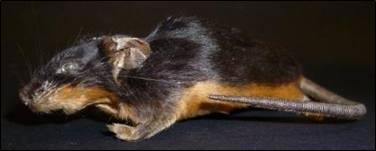Specimen of the Week: Week Seventy-Five
By Emma-Louise Nicholls, on 18 March 2013
 Being a zoologist, wildlife photographer and world traveller, I spend a lot of my time tramping through forests and rummaging around in undergrowth, searching for this mammal, that insect or the other reptile. Sometimes this subsequently requires a first aid kit, sometimes it does not. But either way it nearly always ends in an image that at the very least documents the presence of a species in the area, and at best goes in my folder marked ‘To win Wildlife Photographer of the Year’. You may feel that there aren’t many opportunities for this sort of shenanigan in the middle of the big smoke, but London has some amazing wildlife watching spots. One of my favourite is the underground. Standing on the edge (not too close) of the platform, peering (carefully) down the dark tunnels- if you’re lucky, you’ll catch a glimpse of a small mammal. This week’s Specimen of the Week is…
Being a zoologist, wildlife photographer and world traveller, I spend a lot of my time tramping through forests and rummaging around in undergrowth, searching for this mammal, that insect or the other reptile. Sometimes this subsequently requires a first aid kit, sometimes it does not. But either way it nearly always ends in an image that at the very least documents the presence of a species in the area, and at best goes in my folder marked ‘To win Wildlife Photographer of the Year’. You may feel that there aren’t many opportunities for this sort of shenanigan in the middle of the big smoke, but London has some amazing wildlife watching spots. One of my favourite is the underground. Standing on the edge (not too close) of the platform, peering (carefully) down the dark tunnels- if you’re lucky, you’ll catch a glimpse of a small mammal. This week’s Specimen of the Week is…
**The House Mouse**

The taxidermy house mouse (Mus musculus) at the Grant Museum of
Zoology. LDUCZ-Z2080
1) The IUCN red list of threatened species categorises animals according to how endangered they are. House mice are currently listed as ‘Least Concern’, but really they belong in their own unique category of threat level; ‘don’t be silly’, as they are one of the most widely ranging and darn right successful mammals in the world. I don’t just mean high profile individuals such as Danger Mouse or Mickey, I mean all of them. House mice are normally grey-brown in colour though our specimen is black with an orange stomach, clearly it lived in a box of Cadbury’s Roses in another life. House mice have an impressive tail that is equal in length to the entire body. It is however the least attractive part of the mouse and would require a serious application of E45, if the mouse version of Spiderman ever grew such an appendage.

Fancy looking pet mice. (Image taken by Polarqueen.
Image taken from commons.wikimedia.org)
2) The presence of house mice is fairly easily detectable due to their rather novel ‘odour’, poor things, a means by which they communicate. Boy mice smell especially strong, which unfortunately resulted in my five boy mice pets being discovered by my less than approving landlord when I was at university, despite my best efforts to mask the smell. When wild house mice invade your home, the most tell-tail (hah) sign of them is the accumulation of droppings. Thankfully mine were in a cage, but there were enough other tell-tale signs for them to get found out nevertheless. Whoops. City mouse-folk tend to be a little larger than their country bumpkin counterparts, and have slightly longer tails. The larger body can presumably be put down to less exercise and a poorer diet, as is the ever growing health epidemic that our modern Homo sapiens diet seems to plague us with. The reason for the longer tail in city mice sparks a flurry of amusing animated comic strips of mice getting their tails stuck in mouse-traps only to be pulled out by their friends. Doing that enough times is sure to increase your tail length no?
3) The long tail is actually for balance and house mice are Olympic level acrobats. No amount of appealing to the judges from the opposition would get them knocked down to Bronze. Typically nocturnal, house mice have highly developed hearing and smell, to sense both danger and prey. Their prey usually includes invertebrates though the city folk will eat most household rubbish including some less savoury snacks such as soap and tobacco. Urgh.

House mouse. (Image taken from
commons.wikimedia.org, author
unknown)
4) House mice like to breed year-round, and why not? With between five and ten litters of four to eight babies subsequently produced within a year, the parents won’t have to worry about their pension not being worth a shilling as they’ll have roughly 57,600 grandchildren to care for them by the time they reach old age. The pups, or pinkies if you feed them to your pet snakes, or mouselets if you’re… me, are born almost naked with sealed eyes and ears. The fur doesn’t take long to kick in though- two weeks and they’re all fluffy and cute. Within three weeks they are fully weaned and just another two weeks after that, they are ready to start having mouselets of their own.
5) House mice have been in Britain since at least the Iron Age, though originally they are most likely to have come from Asia. We are so used to the idea of wild mice living in and around our settlements that it seems almost odd to think of them living without any human association and yet, manage, they do. The properly-wild variety of house mouse will nest in rock crevices or in burrows beneath the ground. Who’d have thought barns were not the natural habitat of this species? Weird.
Emma-Louise Nicholls is the Museum Assistant at the Grant Museum of Zoology
 Close
Close

